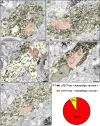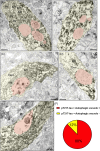Nanoscale imaging of pT217-tau in aged rhesus macaque entorhinal and dorsolateral prefrontal cortex: Evidence of interneuronal trafficking and early-stage neurodegeneration
- PMID: 38445818
- PMCID: PMC11032534
- DOI: 10.1002/alz.13737
Nanoscale imaging of pT217-tau in aged rhesus macaque entorhinal and dorsolateral prefrontal cortex: Evidence of interneuronal trafficking and early-stage neurodegeneration
Abstract
Introduction: Tau phosphorylated at threonine-217 (pT217-tau) is a novel fluid-based biomarker that predicts onset of Alzheimer's disease (AD) symptoms, but little is known about how pT217-tau arises in the brain, as soluble pT217-tau is dephosphorylated post mortem in humans.
Methods: We used multilabel immunofluorescence and immunoelectron microscopy to examine the subcellular localization of early-stage pT217-tau in entorhinal and prefrontal cortices of aged macaques with naturally occurring tau pathology and assayed pT217-tau levels in plasma.
Results: pT217-tau was aggregated on microtubules within dendrites exhibiting early signs of degeneration, including autophagic vacuoles. It was also seen trafficking between excitatory neurons within synapses on spines, where it was exposed to the extracellular space, and thus accessible to cerebrospinal fluid (CSF)/blood. Plasma pT217-tau levels increased across the age span and thus can serve as a biomarker in macaques.
Discussion: These data help to explain why pT217-tau predicts degeneration in AD and how it gains access to CSF and plasma to serve as a fluid biomarker.
Keywords: biomarker; dorsolateral prefrontal cortex; entorhinal cortex; plasma; tau phosphorylated at threonine‐217; trafficking.
© 2024 The Authors. Alzheimer's & Dementia published by Wiley Periodicals LLC on behalf of Alzheimer's Association.
Conflict of interest statement
Dr. Zhongcong Xie provided consulting service to Baxter pharmaceutical company; Shanghai 9th and 10th hospitals; NanoMosaic, Inc.; and Anesthesiology and Perioperative Science in the past 36 months. All other co‐authors have nothing to disclose. Author disclosures are available in the supporting information.
Figures








Update of
-
Nanoscale imaging of pT217-tau in aged rhesus macaque entorhinal and dorsolateral prefrontal cortex: Evidence of interneuronal trafficking and early-stage neurodegeneration.bioRxiv [Preprint]. 2023 Nov 10:2023.11.07.566046. doi: 10.1101/2023.11.07.566046. bioRxiv. 2023. Update in: Alzheimers Dement. 2024 Apr;20(4):2843-2860. doi: 10.1002/alz.13737. PMID: 37986900 Free PMC article. Updated. Preprint.
Similar articles
-
Nanoscale imaging of pT217-tau in aged rhesus macaque entorhinal and dorsolateral prefrontal cortex: Evidence of interneuronal trafficking and early-stage neurodegeneration.bioRxiv [Preprint]. 2023 Nov 10:2023.11.07.566046. doi: 10.1101/2023.11.07.566046. bioRxiv. 2023. Update in: Alzheimers Dement. 2024 Apr;20(4):2843-2860. doi: 10.1002/alz.13737. PMID: 37986900 Free PMC article. Updated. Preprint.
-
MAPT R406W increases tau T217 phosphorylation in absence of amyloid pathology.Ann Clin Transl Neurol. 2021 Sep;8(9):1817-1830. doi: 10.1002/acn3.51435. Epub 2021 Aug 2. Ann Clin Transl Neurol. 2021. PMID: 34342183 Free PMC article.
-
CSF tau phosphorylation occupancies at T217 and T205 represent improved biomarkers of amyloid and tau pathology in Alzheimer's disease.Nat Aging. 2023 Apr;3(4):391-401. doi: 10.1038/s43587-023-00380-7. Epub 2023 Mar 13. Nat Aging. 2023. PMID: 37117788 Free PMC article.
-
The etiology and prevention of early-stage tau pathology in higher cortical circuits: Insights from aging rhesus macaques.Alzheimers Dement. 2025 Feb;21(2):e14477. doi: 10.1002/alz.14477. Epub 2025 Jan 8. Alzheimers Dement. 2025. PMID: 39776253 Free PMC article. Review.
-
Biomarkers for Alzheimer's disease: current status and prospects for the future.J Intern Med. 2018 Dec;284(6):643-663. doi: 10.1111/joim.12816. Epub 2018 Aug 19. J Intern Med. 2018. PMID: 30051512 Review.
Cited by
-
Sequence and trajectory of early Alzheimer's disease-related tau inclusions in the hippocampal formation of cases without amyloid-β deposits.Acta Neuropathol. 2025 May 23;149(1):50. doi: 10.1007/s00401-025-02862-x. Acta Neuropathol. 2025. PMID: 40407905 Free PMC article.
-
The aged female rhesus macaque as a translational model for human menopause and hormone therapy.Horm Behav. 2024 Nov;166:105658. doi: 10.1016/j.yhbeh.2024.105658. Epub 2024 Nov 11. Horm Behav. 2024. PMID: 39531811
-
A Single-Chain Variable Fragment Antibody Alleviates Inflammation and Apoptosis of Neurons by Inhibiting Tau Aggregation.Biomolecules. 2025 Jun 15;15(6):872. doi: 10.3390/biom15060872. Biomolecules. 2025. PMID: 40563512 Free PMC article.
-
Inhibition of brain glutamate carboxypeptidase II (GCPII) to enhance cognitive function.Adv Pharmacol. 2025;102:27-63. doi: 10.1016/bs.apha.2024.10.018. Epub 2024 Nov 5. Adv Pharmacol. 2025. PMID: 39929583 Free PMC article. Review.
-
The potential dual role of tau phosphorylation: plasma phosphorylated-tau217 in newborns and Alzheimer's disease.Brain Commun. 2025 Jun 7;7(3):fcaf221. doi: 10.1093/braincomms/fcaf221. eCollection 2025. Brain Commun. 2025. PMID: 40574977 Free PMC article.
References
MeSH terms
Substances
Grants and funding
LinkOut - more resources
Full Text Sources
Medical

